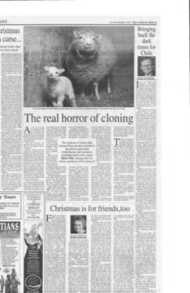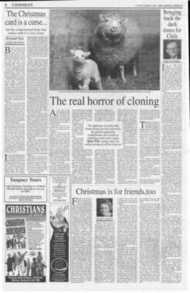Page 8, 25th December 1998
Page 8

Report an error
Noticed an error on this page?If you've noticed an error in this article please click here to report it.
Tags
Share
Related articles
Human Cloning: Is It Mankind's Second Fall?
I Did My Doctoral Thesis On The Classical Philosophical...
Cloning Condemned By European Union
Singing The Lord's Song On Alien Soil
The real horror of cloning
T THIS TIME Of year, our thoughts turn with joy to the birth of Our rd. We think of the extraordinary and marvellous event which preceded this birth by nine months: the conception of God himself in the body of the Virgin Mary.
This year, however, our thoughts have also been turning o a very different kind of conception.
Human cloning was the subject of a recent report of the Human Genetics Advisory Commission and the Human Fertilisation and Embryology Authority. The report supports a ban on cloning where the aim is to bring the clone to birth. Where the clone will, instead, be used in research and/or as a source of spare parts, cloning is seen as permissible and, indeed, highly desirable. The report thus defends, by way of exception, what should be regarded as the worst form of cloning: cloning where the clone produced will be used and destroyed.
Already a scientist is said to have cloned himself using eggs from a cow: 52 eggs deprived of their nuclei were fused with 52 cells from the scientist's own body. When asked how he felt about destroying 52 potential copies of himself, the scientist engagingly replied that he had given the matter no thought. Adminedly, the status of the entities resulting from the experiment is unclear. However, it is possible that some of them, at least, were real, though damaged, human embryos, who lived and died to serve a scientific goal.
What can be learnt from these developments? Cloning, paradoxically. has something to teach us with regard to the meaning of human procreation in the natural situation. As the Creed tells us. the Second Person of the Blessed Trinity is "begotten, not made".
A similar distinction can be made in the context of human procreation. We beget our equals— other human beings. We make or produce factory parts. Of course, God himself — who is hardly our equal — is righdy said to "make" human beings. However, even God does not produce human beings, in the sense of constructing them entirely from existing materials. The soul which gives life is created by God not from existing mated
aLs, but from nothing at all.
Moreover. God allows the human parents to participate in his act of creation, in so far as their sexual union creates the preconditions for it. As far as the parents' contribution is concerned, the child is "begotten, not made". Where this "begetting" is replaced by laboratory "production", as in the case of cloning, the child is liable to be treated as the product which, on the human side, it is. This danger is not, of course, confuted to cloning, but is also found in IVF. Those who foresee that human clones will be treated as the property of those who produce them can point to the way IVF embryos are treated when they are surplus to requirements. If cloning dehumanises human reproduction, so, too, does IW.
However, cloning does raise some new issues, in addition
to those raised by EVE There is even more to be said for sexual conception than we may have realised. Marital intercourse "open to life" is, not surprisingly, perfectly adapted to human generation. It is an interpersonal act which has its own significance in the marriage of the couple, and which can be further "crowned" or "completed" by the gift of a child. Here there is no manipulation of materials, or indeed, of persons. Instead. there is giving and receiving open to a further. Divine gift of life.
But procreation, if it should occur, has an additional symbolic content at the level of fertilisation itself. The fusion of the parents' genetic contributions to form a new and distinct individual can be seen as both a symbol of relatedness, and at the same time one of difference. The child is genetically related to both parents, but is still genetically unique, just as his or her life is both a new start and owes a debt to the past. The child embodies the union of the parents, both in his or her coming to be and in his or her new, though related, genetic constitution.
Of course, at Christmas we celebrate the birth of a child who was not so conceived. No other human being but Mary provided the genetic material of her Son; no other act than that of God himself brought about the Incarnation.
TtiE SECOND PERSON of he Blessed Trinity, eternally begotten by the Father, assumed a human nature at a certain point in time. This is not "production", but nor is it anything approaching normal human procreation. The very contribution of two human parents, which is so essential in the normal case, was bypassed so as to make clear the divine origin of the child. Just as sexual procreation in marriage is on a different plane to laboratory conception, so the Incarnation is infinitely far above sexual procreation, wonderful and mysterious as such procreation is.
The virginal conception through which the Incarnation took place is not, as some would have it, an adverse reflection on sexual procreation.
On the contrary, it is an extraordinary event which is, for that very reason. appropriate to a kind of intervention in history which has happened once and for all.
Helen Watt is Research Fellow at the linacre Centre for Health Care Ethics in London
blog comments powered by Disqus















